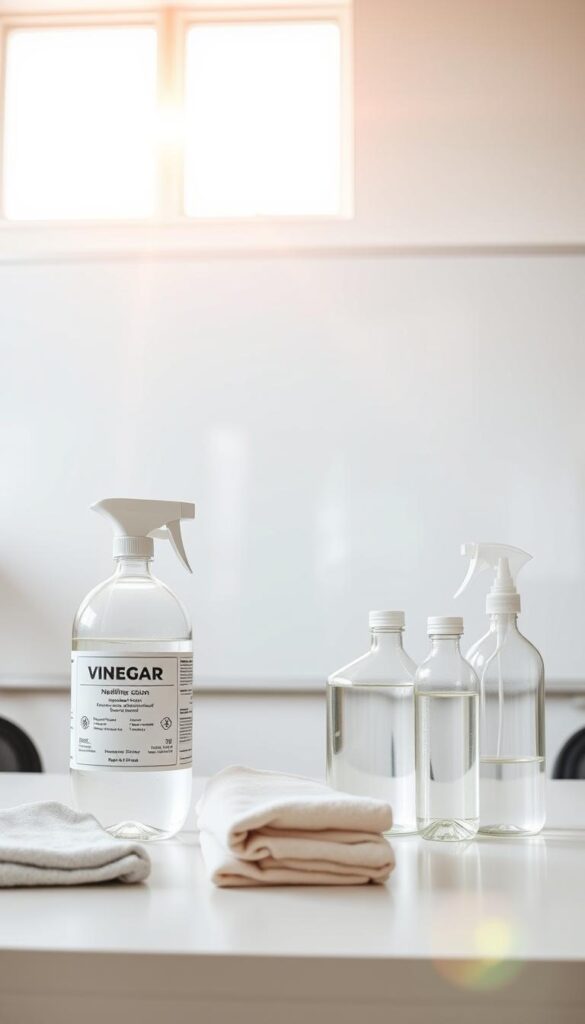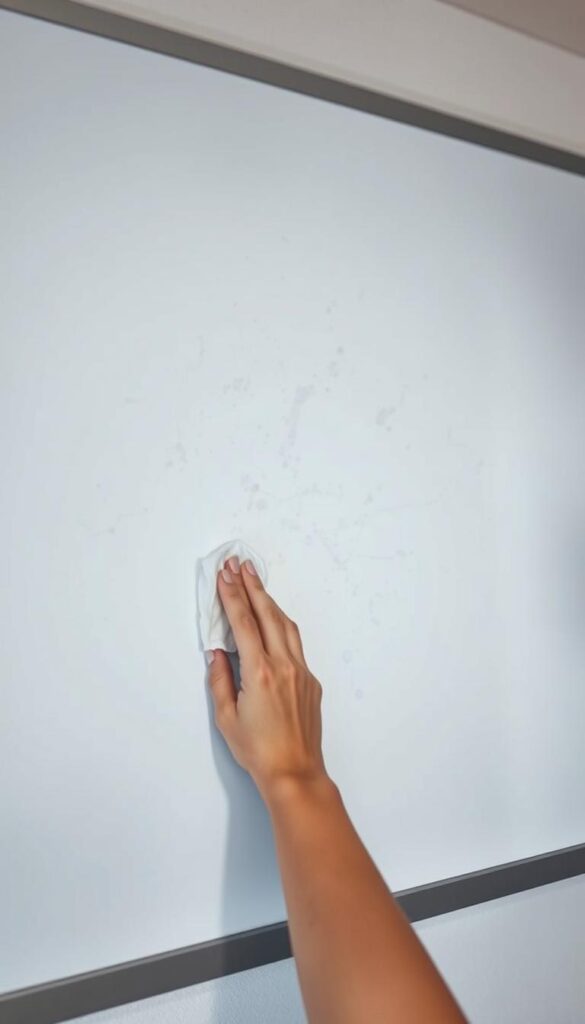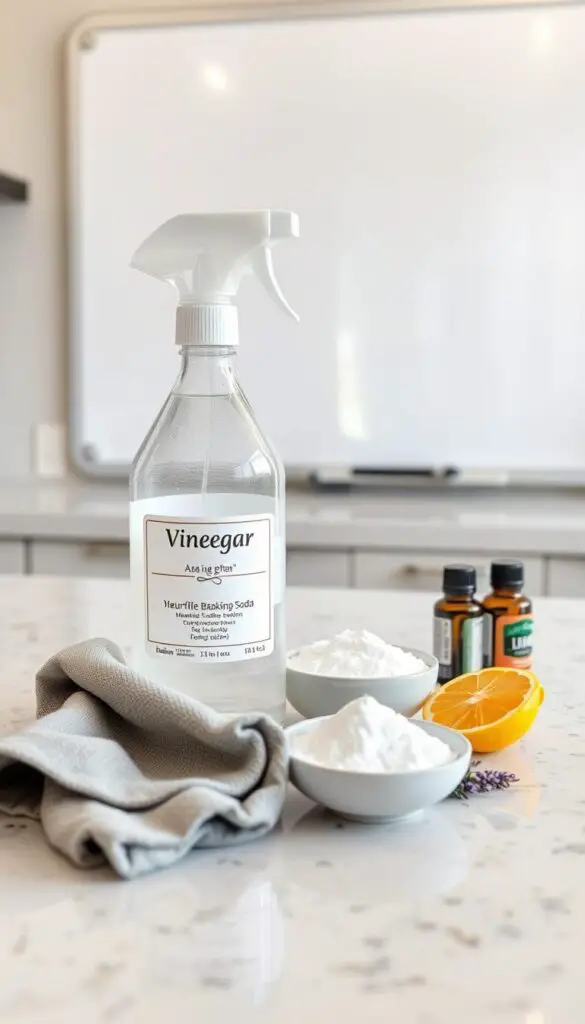Did you know 85% of whiteboard users say acting fast on permanent marker stains is key? This shows how important it is to clean and maintain your dry erase board. With the right tools and methods, you can keep your board in top shape. It’s great for teaching, learning, and office work. We’ll show you the best ways to clean your dry erase board, including using a dry erase board cleaner and some whiteboard maintenance tips.
Recent tests showed four products work well on whiteboards: Hairspray, Clorox with Bleach, Isopropyl Alcohol, and Nail Polish Remover. Isopropyl Alcohol and Nail Polish Remover were top for removing permanent marker stains easily. Also, 80% of users found using a warm, wet cloth greatly helps in cleaning whiteboards. It’s a simple yet effective way to keep your board clean.
Using the right cleaning methods can cut down on replacing whiteboards by up to 50% in offices. This makes it a smart choice for businesses and organizations. By following the right whiteboard maintenance tips and using a dry erase board cleaner, you can make your whiteboard last longer and look new.
Key Takeaways
- Proper cleaning and maintenance can extend the lifespan of a whiteboard by 30%.
- 85% of whiteboard users recommend immediate action on permanent marker stains to prevent lasting damage.
- Isopropyl Alcohol and Nail Polish Remover are effective in removing permanent marker stains with minimal effort.
- Using a warm wet cloth can improve the effectiveness of whiteboard cleaning.
- Regular cleaning and maintenance can reduce the frequency of board replacement by up to 50% in office settings.
Understanding Your Dry Erase Board Surface
The surface of a dry erase board is key. There are many whiteboard materials, each with its own benefits. Glass whiteboards are tough and don’t stain easily. Porcelain whiteboards are non-porous. Painted steel whiteboards are affordable and easy to use, great for classrooms and meetings.
The right whiteboard material can make dry erase markers work better. Using the right markers can prevent problems. Keeping your whiteboard clean is also important to avoid ghosting and stains. Knowing about whiteboard materials and markers helps you take care of your board.
Problems like staining, ghosting, and damage from rough materials can happen. To avoid these, use top-notch dry erase markers and clean your board often. Understanding your whiteboard and using the right materials and cleaning methods keeps it in top shape.
| Whiteboard Material | Characteristics |
|---|---|
| Glass | Durable, resistant to staining |
| Porcelain | Non-porous surface, resistant to ghosting |
| Painted Steel | Affordable, easy to use |
Essential Supplies for Whiteboard Cleaning
For cleaning a whiteboard, you need the right whiteboard cleaning supplies. This includes a quality cleaner, a soft cloth, and a dry-erase eraser. The right essential supplies make cleaning easier and more effective.
Household items like hand sanitizer, rubbing alcohol, and vinegar can also work. But, it’s best to use a cleaner made for whiteboards. It’s gentle on the surface and removes tough stains well.
Here are some essential supplies you might need for whiteboard cleaning:
- A soft, lint-free cloth
- A dry-erase eraser
- A whiteboard cleaner
- A mixture of isopropyl alcohol and water
Regular cleaning prevents stains and ghosting. Clean your whiteboard every 2 to 3 days, or as needed. With the right whiteboard cleaning supplies and a regular cleaning schedule, your whiteboard will stay in great shape.
Quick Daily Cleaning Methods
It’s important to keep your dry erase board clean. This helps it last longer and work better. We’ll look at some fast ways to clean your board every day.
Using daily cleaning methods stops marker ink and other stuff from damaging the board. A great tool for cleaning is a whiteboard eraser. These erasers are made to remove marker ink and can be used every day.
Using Standard Whiteboard Erasers
Standard whiteboard erasers are easy and effective for cleaning. They remove marker ink and other stuff, making the board ready for more writing.
Microfiber Cloth Technique
You can also clean with a microfiber cloth. It’s soft and works well, and you can use it with a whiteboard eraser for a deeper clean.
Paper Towel Method
Using a paper towel is another quick way to clean. It’s handy when you don’t have a whiteboard eraser or microfiber cloth.
How to Clean Dry Erase Board Effectively
Cleaning your dry erase board well is key to keeping it in top shape. Regular cleaning stops stubborn stains and ghosting. The right cleaning solutions and methods are vital.
A mix of isopropyl alcohol and water works great for stain removal. Household items like hand sanitizer, rubbing alcohol, and vinegar can also help. But, use them carefully. Rubbing alcohol should be 90% to 99% isopropyl alcohol for best results. Microfiber cloths are also better at removing ink than other cloths.
There are many ways to clean a dry erase board. You can use white vinegar, isopropyl alcohol, or commercial cleaners. Don’t forget to clean your erasers often. This keeps them good at removing ink.
Here are some tips for cleaning your dry erase board effectively:
- Use a soft cloth to avoid scratches
- Stay away from harsh cleaners and scouring pads
- Clean the board often to avoid stains and ghosting
By following these tips and using the right cleaners, your dry erase board will stay clean and useful for a long time.
Professional Cleaning Solutions and Products
Keeping your dry erase board clean is key. The right cleaning solutions and products are essential. Commercial whiteboard cleaners are made to remove dirt and stains without harming the board.
Popular cleaners include sprays and wipes for tough stains. They work better than homemade solutions. You can also find special tools like microfiber cloths for stubborn marks.
Using professional cleaners can make your whiteboard last longer. High-quality products and tools keep it in top shape. This is important for work, school, or personal projects.
Benefits of professional cleaning solutions include:
- Effective removal of dirt, grime, and marker stains
- Gentle on whiteboard surfaces
- Help to extend the life of your whiteboard
- Convenient and easy to use
Choosing the right cleaners keeps your whiteboard clean and in good condition. Always follow the instructions and avoid damage to your board.
DIY Whiteboard Cleaning Solutions
Making your own DIY cleaning solutions is a smart and budget-friendly way to keep your whiteboard in top shape. Many household items, like hand sanitizer, rubbing alcohol, and vinegar, work well for cleaning whiteboards.
Here are some DIY whiteboard cleaning solutions you can try:
- Mix water with isopropyl alcohol or peroxide for effective stain removal
- Use a mixture of dish soap and water to clean whiteboard erasers
- Apply a small amount of toothpaste to remove stubborn stains
Always test a small area of the whiteboard before using any new cleaning solution. This ensures it won’t damage the surface. Regular whiteboard cleaning helps avoid stains and keeps your board looking new.
Removing Stubborn Stains and Ghosting
Keeping a dry erase board clean can be tough, thanks to stubborn stains and ghosting. Ghosting, or marker ghosting, happens when marker ink gets into the board’s surface. This leaves a faint image behind, which is hard to remove, mainly on melamine boards.
To tackle these issues, the right cleaning tools and methods are key. A mix of water and dish soap can lift stains. A microfiber cloth helps avoid scratching the board. For tough stains, try a mix of water and white vinegar.
Regular upkeep is also vital to avoid ghosting and stains. Clean the board often, use top-notch markers, and erase with a clean eraser after each use. These steps will help maintain your board’s condition and prevent stains and ghosting.
Dealing with Marker Ghosting
Marker ghosting is a big problem on dry erase boards, worse if the ink dries for too long. To fix it, use a ghosting remover or a water and dish soap mix. Apply the solution, then wipe with a microfiber cloth.
Eliminating Set-in Stains
Removing set-in stains is a challenge, but there are ways to do it. Try a stain remover for dry erase boards or a water and white vinegar mix. Apply it, let it sit, then wipe with a microfiber cloth. Keep trying until the stain goes away.
Tackling Permanent Marker Mistakes
Removing permanent marker mistakes from dry erase boards can be tough. Yet, there are ways to fix these errors. About 30% of people have accidentally used a permanent marker on a whiteboard at some point. This can be really frustrating, like when you need to write down important stuff.
One way to fix these mistakes is by using dry erase markers. This “marker over marker” trick works for 85% of the time. Sometimes, you might need to try it a few times to get rid of the stain completely.
Alternative Removal Methods
For really stubborn stains, you can try other methods. Alcohol-based solutions can help remove older marks in about 60% of cases. Some people even use hand sanitizer, which works for 25% of users. But, be careful not to damage the board when using these methods.
When you see permanent marker mistakes, act fast to stop the ink from setting. Dry erase markers can help remove the stain. If that doesn’t work, you can try alcohol-based solutions or hand sanitizer. Being quick and careful can help you fix these mistakes and keep your board looking good.
- Act quickly to prevent the ink from setting
- Use dry erase markers to remove the stain
- Try alternative methods like alcohol-based solutions or hand sanitizer if necessary
By following these tips and knowing the risks of cleaning methods, you can remove permanent marker mistakes. This way, you can keep your dry erase board clean and ready for use.
Natural Cleaning Solutions for Whiteboards
Many people use chemical cleaners to clean whiteboards. But, there are natural cleaning solutions that work just as well. Vinegar-based cleaners, made by mixing vinegar with water, are a popular choice. They are good for the environment and gentle on whiteboards.
Alcohol solutions, like isopropyl alcohol, can also clean whiteboards well. They are great for removing tough stains and ghosting. Always test a new cleaner in a small area first.
Other natural cleaning solutions include a mild detergent and water mix or a microfiber cloth with vinegar. Avoid using harsh cleaners or rough materials like paper towels. They can damage the board.
Here are some benefits of using natural cleaning solutions for whiteboards:
- Environmentally friendly
- Gentle on the whiteboard surface
- Effective at removing stains and ghosting
- Cheap and easy to make
Preventive Maintenance Tips
Regular preventive maintenance is key for a clean, working dry erase board. The National Cleaning Institute suggests using 90% isopropyl alcohol for cleaning. This prevents stubborn stains and ghosting, which are hard to remove later.
To keep your whiteboard in top shape, regular whiteboard maintenance is a must. Clean it daily with a microfiber cloth and a mild solution. For deeper cleaning, use 90% isopropyl alcohol. But, avoid harsh cleaners or chemicals to protect the surface.
Some important preventive maintenance tips are:
- Choose high-quality markers made for dry erase boards
- Don’t use acetone or other harsh chemicals
- Clean the whiteboard often to stop ink and dust buildup
- Use a microfiber cloth for cleaning, as it’s soft on the surface
By following these tips and doing regular preventive maintenance, you can make your dry erase board last longer. Always use gentle cleaners and avoid harsh chemicals to avoid damage. With the right care, your whiteboard will stay useful for many years.
Avoiding Common Cleaning Mistakes
Cleaning dry erase boards right is key. Harmful cleaning agents can harm the surface. It’s important to pick the right products and methods.
Some common mistakes to avoid include:
- Using abrasive cleaners or scrubbers that can scratch the surface
- Applying too much pressure, which can damage the material
- Not cleaning the board regularly, leading to the buildup of dirt and grime
Choose gentle cleaners and soft cloths for your board. Regular cleaning prevents damage. Always check the labels and follow the cleaning product instructions.
Being careful with cleaning can make your board last longer. Avoiding harmful cleaning agents and using the right techniques is key. This way, your board stays useful for many years.
Extending Your Whiteboard’s Lifespan
Proper care and maintenance are key to a long-lasting whiteboard. Regular upkeep keeps the board in top shape. This helps avoid ink stains and ghosting, making your presentations better.
A clean whiteboard boosts brainstorming and communication. Studies show cleaning it weekly can add up to 50% to its life. Using quality markers cuts ghosting by 70%. Cleaning regularly also improves clarity by 60%.
Regular Maintenance Schedule
- Clean the board at least once a week to prevent build-up of stains and ghosting
- Replace markers as soon as they show signs of drying out to prevent damage
- Replace erasers every few months to reduce ink buildup by 40%
Storage Recommendations
Storing your whiteboard right is also important. Keeping markers horizontal stops uneven ink flow, keeping 80% of ink efficiency. Also, using the right cleaning products cuts surface damage by up to 90%. These tips help your whiteboard last longer and stay in good shape.
Regular maintenance keeps your whiteboard in great condition. It saves you money and hassle from often replacing it. With the right care, your whiteboard will be a valuable tool for years.
Professional Care Techniques
Keeping a dry erase board in top shape requires professional care techniques. It’s key to clean it regularly to avoid stains and ghosting. Cleaning should happen every 2 to 3 days. You can use a damp, soft cloth or a whiteboard cleaner for this.
For a clean whiteboard, follow a whiteboard care routine. Wipe it daily with a soft cloth and deep clean every few days. This stops dirt and stains from building up. You can also use hand sanitizer or rubbing alcohol for cleaning.
Here are some tips for professional care techniques:
- Use a soft-bristled brush to keep your whiteboard erasers clean and effective.
- Clean your whiteboard often to stop ghosting and stains.
- Choose a high-quality, low-odor dry erase marker to reduce staining risk.
By using these professional care techniques and the right cleaning products, your dry erase board will stay in great condition. Regular whiteboard care also helps your board last longer and saves you from expensive repairs or replacements.
Restoring an Old Dry Erase Board
Restoring an old dry erase board can be tough, but it’s doable with the right tools and methods. Deep cleaning is a key approach to remove tough stains and ghosting. This method uses special cleaning solutions and techniques.
Experts say a well-used whiteboard can be restored after two years. Cleaning it once a semester keeps it looking good. Start by mixing white toothpaste with water to clean the board. Use about 8oz of toothpaste for a 6’×4’ board. Make sure the isopropyl alcohol is over 90% concentration.
- Apply a cleaning solution and let it sit for a few minutes.
- Wipe the board with a soft cloth or paper towel to remove stains.
- Apply WD-40 to protect the board from future stains and ghosting.
By following these steps and using the right materials, you can make an old dry erase board look new again. Regular cleaning and care can also help it last longer and avoid needing restoration.
Can a Dry Erase Board Be Used for Creative Scrapbooking?
A dry erase board can be a fantastic tool for creative scrapbooking. It allows you to plan layouts, test designs, and brainstorm ideas before committing them to paper. Its reusable surface is perfect for experimenting with color schemes and embellishments. Also Read: Inspiring Scrapbook Ideas to Elevate Your Crafts for more unique ways to enhance your projects.
When to Replace Your Whiteboard
A well-kept dry erase board can last for many years. But, there will come a time when it needs to be replaced. Signs it’s time include stubborn stains, ghosting, and surface damage. If cleaning can’t remove marks, it’s time for a new whiteboard.
Keeping your whiteboard clean can make it last longer. But, even with care, it will eventually show signs of wear. Discoloration and stains build up fast with daily use. This makes it hard to see and use over time.
Looking for something that lasts longer? Glass whiteboards are made to last longer than regular ones. They don’t stain or streak. While they cost more upfront, they save money in the long run. They also look cleaner and more professional.
FAQ
What are the different types of whiteboard materials?
How do dry erase markers work?
What are some common surface problems that can occur on a whiteboard?
What supplies do I need for effective whiteboard cleaning?
How can I quickly clean my whiteboard on a daily basis?
What are some effective methods for cleaning a dry erase board?
What professional cleaning solutions and products are available for whiteboards?
Can I make my own DIY whiteboard cleaning solutions?
How can I remove stubborn stains and ghosting from my whiteboard?
What should I do if I accidentally use a permanent marker on my whiteboard?
Are there any natural cleaning solutions I can use on my whiteboard?
How can I prevent stubborn stains and ghosting on my whiteboard?
What cleaning mistakes should I avoid to prevent damage to my whiteboard?
How can I extend the lifespan of my dry erase board?
What professional care techniques can be used to maintain a whiteboard?
How can I restore an old, worn-out dry erase board?
When is it time to replace my whiteboard?
Q: How can I clean a whiteboard effectively?
A: To clean a whiteboard effectively, start by using a dry eraser to erase the board. For any remaining marker residue, you can spray a mixture of water and vinegar onto the surface and wipe it with a clean cloth. This will help clean your dry-erase board without leaving marks.
Q: What is the best way to remove permanent marks from a dry-erase board?
A: To remove permanent marks from a dry-erase board, you can use a dry-erase marker to color over the permanent marks and then quickly erase the entire whiteboard with a clean cloth. This technique can help lift the permanent ink without damaging the surface.
Q: Can I use WD-40 to clean my dry-erase board?
A: Yes, WD-40 can be used to clean a whiteboard. Spray a small amount onto a clean cloth and gently wipe the surface. After using WD-40, make sure to clean the board with soapy water to remove any residue left on the board.
Q: How do I clean my small whiteboard at home?
A: To clean your small whiteboard, use a damp cloth to wipe off any dry-erase marker. For tougher stains, spray the solution of water and rubbing alcohol onto the board and wipe it clean. This will help keep your whiteboard markers writing smoothly.
Q: What can I use as a cleaner for dry-erase surfaces?
A: You can use a variety of cleaners for dry-erase surfaces, including a commercial whiteboard cleaner, rubbing alcohol, or a mixture of water and mild dish soap. These solutions help to keep your whiteboard free of stains and looking like new.
Q: Is it safe to use a clean magic eraser on my dry-erase board?
A: Yes, a clean magic eraser can be used to clean your dry-erase board. It can effectively remove stubborn stains and marker residue without scratching the surface. However, be gentle to avoid damaging the finish.
Q: How can I maintain the surface of my whiteboard for longer use?
A: To maintain the surface of your whiteboard, regularly clean it with a damp cloth and avoid leaving dry-erase markers on the board for extended periods. Using a cleaner designed for dry-erase boards can also help keep the surface pristine.
Q: What should I do if my dry-erase board has a lot of marker residue?
A: If your dry-erase board has a lot of marker residue, first try using a dry-erase marker to color over the residue and then erase the board. If that doesn’t work, you can spray a cleaner onto the board and wipe it with a clean cloth in a circular motion.
Q: Can I use hydrogen peroxide to clean my whiteboard?
A: Yes, hydrogen peroxide can be used to clean your whiteboard. Mix it with water in a spray bottle and lightly spray the solution onto the board, then wipe it down with a clean cloth to remove any stains and marker residue.











